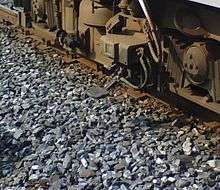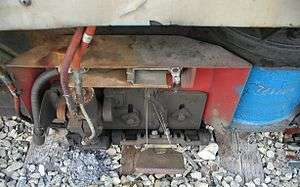Current collector
Electric current collectors are used by trolleybuses, trams, electric locomotives or EMUs to carry electrical power from overhead lines or electrical third rails to the electrical equipment of the vehicles. Those for overhead wires are roof-mounted devices, those for third rails are mounted on the bogies.
Typically, they have one or more spring-loaded arms that press a collector or contact shoe against the rail or overhead wire. As the vehicle moves, the contact shoe slides along the wire or rail to draw the electricity needed to run the vehicle's motor.
The current collector arms are electrically conductive but mounted insulated on the vehicle's roof, side or base. An insulated cable connects the collector with the switch, transformer or motor. The steel rails of the tracks act as the electrical return.
Electric vehicles that collect their current from an overhead line system use different forms of one- or two-arm pantograph collectors, bow collectors or trolley poles. The current collection device presses against the underside of the lowest wire of an overhead line system, which is called a contact wire.
Most overhead supply systems are either DC or single phase AC, using a single wire with return through the grounded running rails. Three phase AC systems use a pair of overhead wires, and paired trolley poles.
Contact shoe
Electric railways with third rails, or fourth rails, in tunnels carry collector shoes projecting laterally (sideways), or vertically, from their bogies. The contact shoe may slide on top of the third rail (top running), on the bottom (bottom running) or on the side (side running). The side running contact shoe is used against the guide bars on rubber-tired metros. A vertical contact shoe is used on ground-level power supply systems, stud contact systems and fourth rail systems. A pair of contact shoes was used on underground current collection systems. The contact shoe on a stud contact system is called a ski collector. The ski collector moves vertically to accommodate slight variations in the height of the studs. Contact shoes may also be used on overhead conductor rails, on guide bars or on trolley wires. Most railways use three rails, while the London Underground uses four rails.
Gallery

 Modern one-arm “pantograph” collector with double collector shoes
Modern one-arm “pantograph” collector with double collector shoes Collector (contact) shoe for a top contact third rail
Collector (contact) shoe for a top contact third rail
 A bow collector on a small electric locomotive
A bow collector on a small electric locomotive A trolleybus with a pair of trolley poles on the roof.
A trolleybus with a pair of trolley poles on the roof. Third rail contact shoe installed on the front Bogie of an RTL-II car for operation into New York Penn Station
Third rail contact shoe installed on the front Bogie of an RTL-II car for operation into New York Penn Station Bumper cars at Taunus Wunderland showing collector poles.
Bumper cars at Taunus Wunderland showing collector poles..jpg) 1882: The first trolleybus in the world by Siemens
1882: The first trolleybus in the world by Siemens
See also
External links
| Wikimedia Commons has media related to Current collectors. |